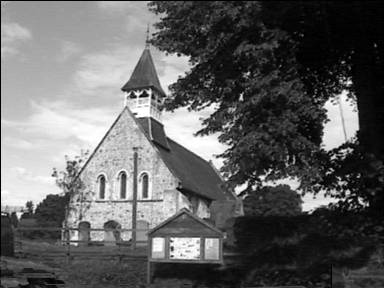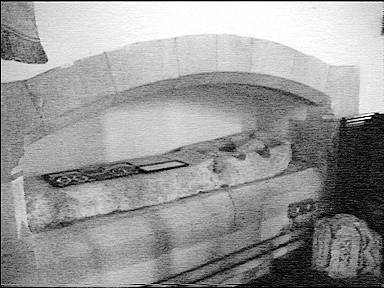![]()

![]()
31. St.Mary the Virgin, East Worldham

St Mary the Virgin, East Worldham
This twelfth century church a few miles east of Alton has been much restored but still retains much charm and interest. The small wooden belfry tower of pagoda shape is Victorian, but in the entrance porch on the south side examples of Roman tiles and bricks are on display. Discovered by grave-diggers in 1945 they indicate the church was built on a Roman site, not improbable considering that the old Roman road from Chichester to Silchester is only 3/4 mile away. The door jambs show consecrated crosses and a mass dial dated 1541.
The interior with its high Victorian timbered roof and red and black tiled floor is somewhat gloomy. Stained glass windows predominate. The three lancets forming the West Window represent Faith, Hope and Charity.
Three windows along the South nave wall have attractive modern glass. One showing St George with a drawn sword, predominantly red in colour, is a memorial to a Squadron Leader V.R. Ferguson D.F.C. surprisingly killed near Quito in Ecuador in 1949. Another commemorates Major Victor Ferguson, possibly his brother, and displays the badge of the 24 South Wales Borderers with a sword above amongst blue hollyhocks and lilies. The third window, mostly pale blue in colour shows a charming representation of the Virgin Mary and Child. On the opposite North wall is a St Francis window showing the saint with the church of San Damian underneath, a memorial to George Knappe a former Rector who died in 1971.

Tomb of Philippa Chaucer
The real surprise of the church is a fourteenth century tomb in the south wall of the nave. There lying peacefully serene is a lady wearing a wimple with a Roel Wheel badge on her breast. Only discovered during Victorian restoration this is believed to be the resting place of Philippa, wife of the famous poet Geoffrey Chaucer. He himself died in 1400 and is buried in Westminster Abbey. She was his second wife, being the daughter of Sir Payne Roel and a former Lady in Waiting to Queen Philippa. Her son Thomas was Lord of the Manor of East Worldham from 1418 to 1434, and this no doubt explains Philippa's surprising burial in this small Hampshire village.
There is no chancel arch but there are a number of interesting memorial tablets in the chancel, especially one to Mr Henry Heighes who died in 1681 aged 63. The epitaph speaks of 'his unshaken loyalty towards his Prince in the worst of times', presumably a reference to the exile of Charles II during the time of Cromwell. Another monument commemorates his son Henry who died in 1692. A number of eighteenth century memorials to the Dance family are to be found on the North Wall of the nave, including that to William Dance who died aged 86 in 1761 leaving '20 shillings a year to the poor of the parish'.
The rounded decorated font standing on four pillars looks Victorian. The church also possesses a Pewter Baptismal Bowl, one of the oldest known in England, but this is only displayed at major festivals.
Finally one recent addition to the church is worthy of close inspection. To the left of the entrance door on the south wall is a beautifully illustrated map of the parish dated 1990. Included in the map are hand painted water colours showing the church and many other features of the village and the nearby countryside. The illustrations include some of the older village buildings such as School House, Tylings Cottage, King John Mill and the 15th century Monkwells. Other paintings show the Alice Holt Forest, hop gardens and sunken lanes, all interspersed with birds and butterflies. This is a real labour of love and a marvellous portrait of East Worldham and the surrounding area.
written by John Symonds
![]() Return to the September 1999 Features page
Return to the September 1999 Features page
![]() return to Home page and main index
return to Home page and main index
page last updated 22 AUGUST 1999